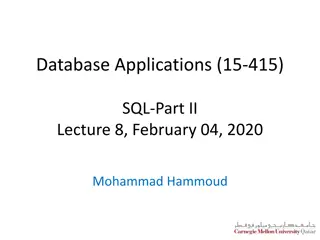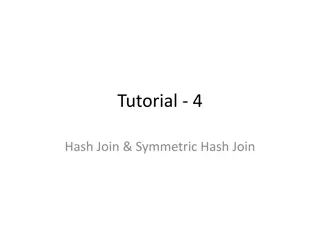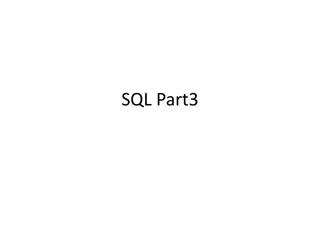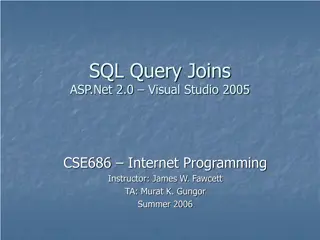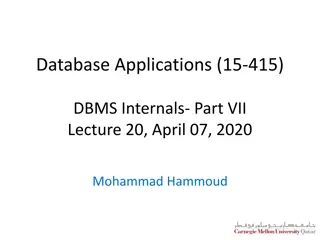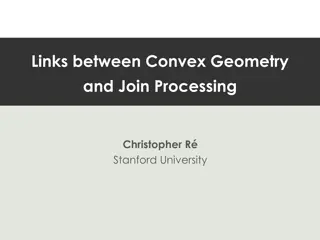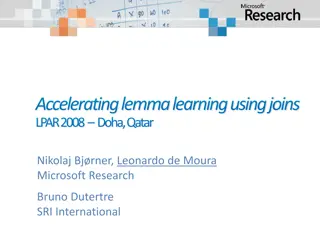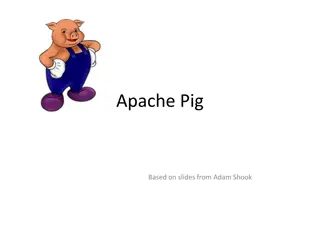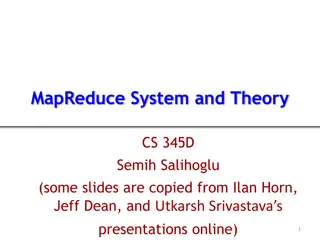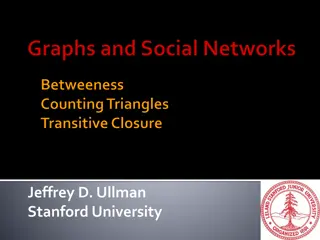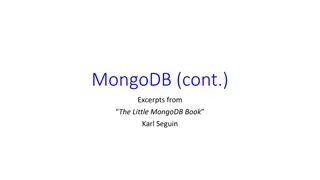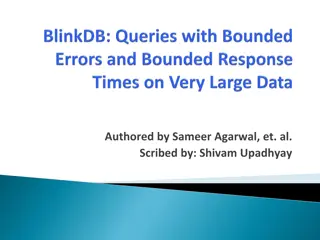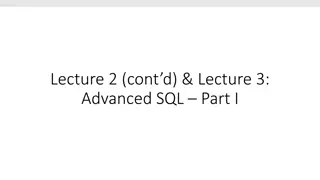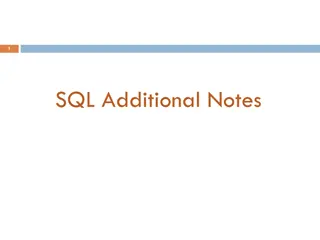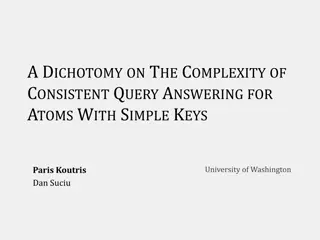Best Spouting in Killinchy
Are you looking for the Best Spouting in Killinchy? Then contact Captain Spouting NZ. They specialise in continuous spouting, meticulously measured and custom-cut to your home. This tailored approach minimises joins, reducing the risk of leaks and imparting a modern, sleek aesthetic to your property
0 views • 6 slides
Understanding Spatial Database Systems: An Overview
This presentation by Xiaozhi Yu introduces the fundamentals of spatial database systems, covering topics such as spatial data types, relationships, system architecture, modeling, and organizing underlying spaces. It delves into the importance of integrating geometry into DBMS data models, spatial in
1 views • 30 slides
Understanding Different Types of SQL Joins
Explore the various types of SQL joins such as INNER JOIN, LEFT (OUTER) JOIN, RIGHT (OUTER) JOIN, and FULL (OUTER) JOIN. Learn how each type functions and the syntax for implementing them. Get insights into examples of INNER JOIN and LEFT OUTER JOIN operations to enhance your SQL knowledge.
0 views • 26 slides
Understanding Joins in DBMS: INNER JOIN, LEFT JOIN, and Examples
Join statements in DBMS, such as INNER JOIN and LEFT JOIN, are used to combine data from multiple tables based on a common field. INNER JOIN selects rows that satisfy a condition from both tables, while LEFT JOIN returns all rows from the left table and matching rows from the right table. Examples i
3 views • 19 slides
Winter Campaign 2019 Membership Growth Overview
The Winter Campaign 2019 Membership Growth at YMCA of Metropolitan Milwaukee saw positive trends and key drivers contributing to revenue and unit growth. The campaign focused on Better Together initiatives, Financial Assistance, Cause Driven Tours, and Lead Generation strategies. Membership marketin
1 views • 8 slides
Exploring SQL Queries and Joins in Database Applications Lecture
Discover a comprehensive overview of SQL queries, including nested and deeply nested queries, in the context of database applications. Learn about joining tables, finding sailors who reserved specific boats, handling NULL values, and more in this informative lecture featuring examples and explanatio
0 views • 53 slides
SQL Part II Lecture Summary: Nested Queries, Joins, and Updates for Database Applications
In this SQL lecture, Mohammad Hammoud covers nested queries, insertion, deletion, updates, handling NULL values, join variants, and advanced query techniques. Examples include finding sailors who have reserved specific boats, using nested queries to filter data, and deep nested queries for complex d
0 views • 53 slides
Massively Parallel Sort-Merge Joins in Main Memory Multi-Core Database Systems
Explore the hardware trends and techniques used at Technische Universität München for massively parallel sort-merge joins in main memory multi-core database systems. The research focuses on exploiting fast main memory access, parallelizing algorithms, and optimizing performance in a NUMA environme
0 views • 29 slides
Meet the Dynamic Teaching Team at Caughman Road Elementary!
Miss Jasmin Crawford is a First Grade teacher eager to make a difference, Liz Yarbrough joins as a Lower Elementary Montessori teacher, Kevin Grant Jr. brings excitement to the 5th-grade class amid COVID-19 challenges, Miss Hannah Pappas is a new addition to the Kindergarten team, all dedicated to s
0 views • 5 slides
Understanding Joins, Views, and Subqueries in SQL
This informative guide delves into the essentials of joining, viewing, and utilizing subqueries in SQL. Explore multi-table selects, various join types, and examples of inner, left outer, and right outer joins, offering a clear understanding of how to manipulate and combine data in SQL queries effec
0 views • 28 slides
Understanding Table Joins in SQL
Exploring various types of table joins in SQL, including Cross Join, Inner Join, Outer Join, and Self Join. Learn how these joins work, when to use them, and see practical examples for better comprehension.
0 views • 22 slides
Understanding Hash Joins and Symmetric Hash Joins in Database Queries
Hash joins and symmetric hash joins are key techniques used in database queries to efficiently access and combine data from multiple tables. Hash joins load candidate records into hash tables for quick probing, while symmetric hash joins maintain two hash tables with two hash functions. Despite thei
0 views • 8 slides
SQL Query Optimization Techniques
Learn advanced SQL techniques including subqueries, inserts, updates, joins, and data manipulation to enhance the performance of your database queries efficiently.
0 views • 18 slides
Understanding Joins in DBMS: Types and Operations
Joins in DBMS are binary operations that allow you to combine data from multiple tables using primary and foreign keys. There are two main types of joins: Inner Joins (Theta, Natural, EQUI) and Outer Joins (Left, Right, Full). Inner joins help merge data from tables based on specified conditions, wh
0 views • 16 slides
Understanding SQL Joins in ASP.Net 2.0 with Visual Studio 2005
Exploring the importance of query joins in SQL, this instructional content delves into inner, outer, left outer, and right outer joins for integrating data from multiple database tables in ASP.Net 2.0. Detailed guidance is provided on setting up SQL databases in Visual Studio .NET 2005, creating tab
0 views • 11 slides
Understanding Join Algorithms in Database Systems
This presentation delves into the intricacies of join algorithms in DBMS, focusing on various techniques such as simple nested loops join, block nested loops join, index nested loops join, sort-merge join, and hash join. The importance of optimizing joins to avoid unnecessary cross-products is empha
0 views • 67 slides
Exploring Links Between Convex Geometry and Query Processing
Delve into the intersection of convex geometry and query processing at Stanford University, where theoretical discussions are being applied to real-world database engine development. Learn about the optimization of database joins, the historical evolution of database engines, and the challenges face
0 views • 54 slides
Overview of Different Types of SQL Joins
Examine the various types of SQL joins including INNER JOIN, LEFT JOIN, RIGHT JOIN, and FULL JOIN. Understand the differences between these join types and how they retrieve data from multiple tables based on specified conditions. Explore practical examples of joining tables and creating relationship
0 views • 18 slides
Accelerating Lemma Learning Using Joins in Satisfiability Modulo Theories
Explore the use of joins in accelerating lemma learning within the context of Satisfiability Modulo Theories (SMT). The study covers various SMT applications at Microsoft and delves into the development of the Z3 solver. Key topics include theories, arithmetic operations, array theory, uninterpreted
0 views • 25 slides
Mile Oak FC Monthly Newsletter - June 2021 Highlights
Mile Oak FC's June newsletter showcases the upcoming season's Matchday Kit Refresh, new sponsors, and key appointments. The team is preparing with new kits sponsored by Psydro, Foster & Co, Butlers with Bums, Dean Jackson Waste Disposal, and more. Karen Hilton joins as the new Welfare Officer, overs
0 views • 6 slides
Introduction to Apache Pig: A High-level Overview
Apache Pig is a data flow language developed by Yahoo! and is a top-level Apache project that enables non-Java programmers to access and analyze data on a cluster. It interprets Pig Latin commands to generate MapReduce jobs, simplifying data summarization, reporting, and querying tasks. Pig operates
0 views • 57 slides
Understanding MapReduce System and Theory in CS 345D
Explore the fundamentals of MapReduce in this informative presentation that covers the history, challenges, and benefits of distributed systems like MapReduce/Hadoop, Pig, and Hive. Learn about the lower bounding communication cost model and how it optimizes algorithm for joins on MapReduce. Discove
0 views • 60 slides
Analysis of Drawbacks in BlinkDB System
BlinkDB is a system that focuses on organizing sampling around query column sets and determining query classes with the best efficiency. However, potential failures lie in unstable QCSes, high rare subgroup counts, and challenging dimensionality. Drawbacks include unclear parameter tuning, limited o
0 views • 23 slides
Achieving Success: Slimming World's Communication Effectiveness Strategy
Slimming World successfully increased awareness, positive reputation, and understanding of their weight loss program through targeted communication strategies. By aligning organizational objectives with communication goals and engaging with specific target audiences, they saw significant improvement
0 views • 5 slides
Graph Analysis Techniques and Algorithms
Graph analysis involves utilizing different algorithms for parallelizing activities and performing operations like relational joins efficiently in large graphs with small diameters. Techniques such as dividing graphs into communities based on edge betweenness are explored. Breadth-first search is ap
0 views • 58 slides
Introduction to OpenMP: A Parallel Programming API
OpenMP, an API for multi-threaded, shared memory parallelism, is supported by compilers like C/C++ and Fortran. It consists of compiler directives, runtime library resources, and environment variables. The history spans various specification versions, with features like tasks, SIMD, and memory model
0 views • 33 slides
Exploring MongoDB: Array Operations, Data Modeling, and NoSQL Concepts
Delve into MongoDB array operations such as accessing array elements with $slice, data modeling concepts, and the absence of joins in NoSQL systems. Learn how MongoDB handles relationships, querying nested data, and the nuances of data modeling in comparison to relational databases.
0 views • 43 slides
Betrayal and Arrest of Jesus in Mark 14:43-52
Judas, one of the Twelve disciples, betrays Jesus with a kiss, leading to his arrest by a crowd armed with swords and clubs. A scuffle ensues, where a servant's ear is cut off, but Jesus foretells the fulfillment of Scriptures. Despite his followers fleeing, a young man briefly joins before fleeing
0 views • 22 slides
Understanding BlinkDB: A Framework for Fast and Approximate Query Processing
BlinkDB is a framework built on Hive and Spark that creates and maintains offline samples for fast, approximate query processing. It provides error bars for queries executed on the same data and ensures correctness. The paper introduces innovations like sample creation techniques, error latency prof
0 views • 8 slides
Understanding Data Modeling for Optimal Performance
Data modeling is crucial for efficient relational and non-relational databases. It involves making decisions on normalization, denormalization, embedding, and referencing to optimize performance and minimize costs. By strategically structuring data, you can achieve the benefits of joins without the
0 views • 36 slides
Advanced SQL Concepts and Queries Overview
Today's lecture highlights advanced SQL topics such as multi-table queries, set operators, joins, primary keys, foreign keys, and more. The session covers practical activities and fundamental concepts in database management. Explore the nuances of SQL semantics and understand the importance of keys
0 views • 55 slides
Advances in Big Data Integration and Cleaning Techniques
Explore the latest research on data cleaning and integration techniques in the era of big data. Topics cover similarity joins, real-world data challenges, similarity functions, and applications in near-duplicate object detection and collaborative filtering. Learn about essential operations for data
0 views • 36 slides
SQL Advanced Concepts Overview
This content covers various advanced SQL concepts such as Grouping and Aggregation, Execution Order, Joins, Maximum Finding, and Line Formatting. It provides examples and explanations on how to use these concepts effectively in SQL queries. The visual aids help in understanding the concepts better.
0 views • 17 slides
Dichotomy on Complexity of Consistent Query Answering
The research paper presents a dichotomy on the complexity of consistent query answering for atoms with simple keys. It discusses repairs for uncertain instances in a schema with key constraints, as well as the concept of consistent query answering. The document addresses the problem statement of cer
0 views • 26 slides
Rethinking Database Algorithms for Phase Change Memory
Exploring the potential of Phase Change Memory (PCM) technology, this paper presents algorithm design for PCM-based main memory in the context of database systems. The emerging non-volatile memory technology of PCM is compared to DRAM, showcasing its byte-addressable nature, lower latency, and highe
0 views • 24 slides





